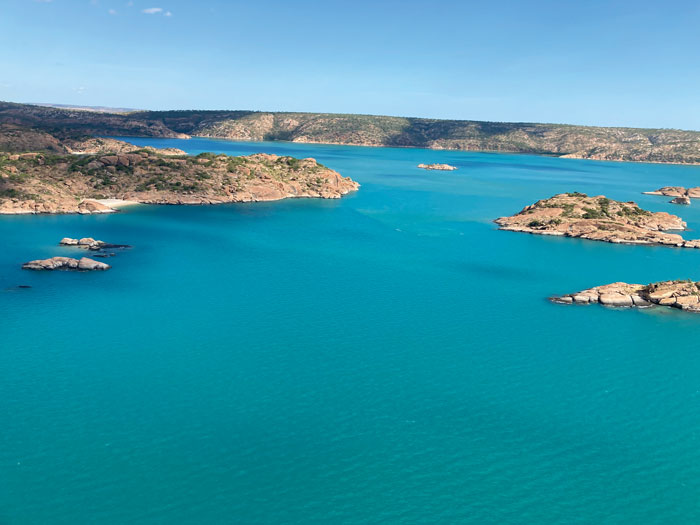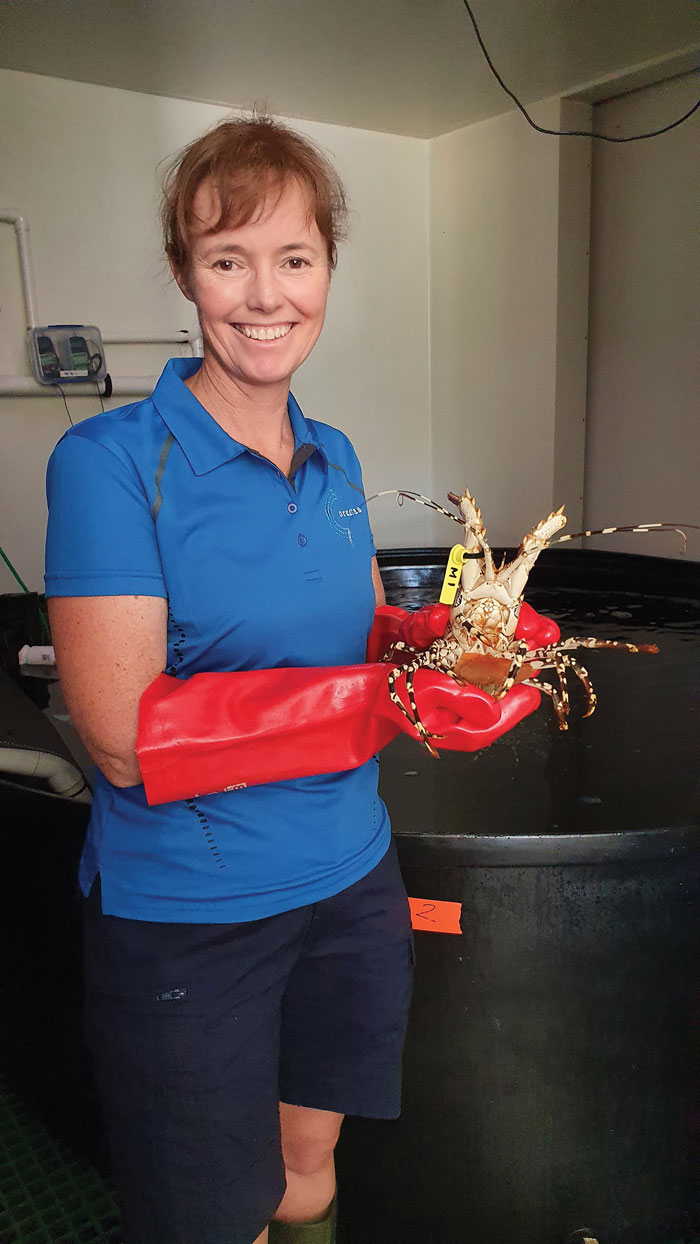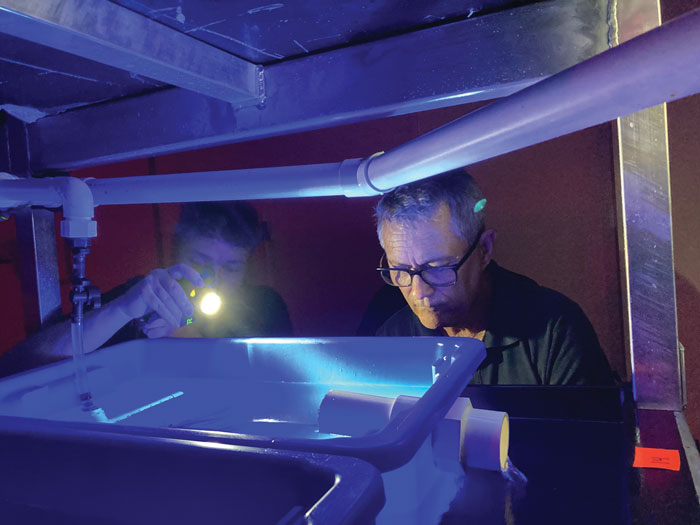Decades in development, rock lobster aquaculture in Australia is gathering pace with hatchery success followed by a new ocean grow-out trial in the west
By Corrina Ridgway

Photo: Jennifer Blair, Ornatas
Efforts to commercially grow Ornate Rock Lobster (Panulirus ornatus) have been hitting development milestones this year, the latest of which is a new grow-out trial launched in May at Cone Bay in Western Australia. Rock lobster aquaculture, the long-time Holy Grail of the seafood sector, finally appears within reach.
Aquaculture company Ornatas and partner Maxima Rock Lobster aim to be producing 1100 tonnes of hatchery-bred, grown-out Ornate Rock Lobster a year by 2030. The launch of their Cone Bay ocean grow-out project is a critical step on that path.
The FRDC and the Cooperative Research Centre for Developing Northern Australia (CRCNA) have together contributed $1.9 million to the $4.5 million project. It will establish Australia’s first ocean grow-out facility for commercial juvenile rock lobster aquaculture.
CRCNA CEO Anne Stünzner is enthusiastic about the potential of the project to transform both rock lobster production and economic opportunities in northern Australia. “It will deliver a high-quality, sustainable Australian seafood to high-value domestic and export markets, and potentially create thousands of direct and indirect jobs over the next decade,” she says.
In Australia, Ornate Rock Lobster is hand harvested from the wild by divers. As a premium seafood product, it has averaged prices of $60 to $70 per kilogram in recent years, with the bulk of Australia’s annual harvest exported.
Ornate Rock Lobster aquaculture is undertaken in other countries where the species also occurs, such as Malaysia, Thailand and Vietnam. However, this is based on ranching animals – catching juveniles from the wild and raising them in farmed conditions.
The aquaculture Australia is developing is based on closing the life cycle for the species, and using hatchery-reared rather than wild-caught juveniles. Ornatas holds the Australian licence to commercialise this novel rock lobster hatchery technology, which was developed at the University of Tasmania (UTAS).
Raised on a raft
The three-year trial at Cone Bay will use raft systems to grow out juveniles, completing the aquaculture cycle for the species in a commercially scalable system. Essential requirements for the trial site include good water depth and water exchange, low seasonal biofouling, protection from excessive currents and visibility from shore.
Ornatas research and development manager Jennifer Blair says the company hopes to see raft structures in the water by September 2021 and juveniles in the system before the end of the year, dependent on satisfying biosecurity requirements and regulations.
Animals are expected to be grown in rafts for 18 months, to a market size of 1.2 kilograms. It follows the establishment of Ornatas’s hatchery in Townsville, Queensland, which produced its first successful commercial hatch of Ornate Rock Lobster over the 2020-21 new year period.
Ornatas CEO Scott Parkinson says the company is ecstatic with progress so far, with the hatch resulting in hundreds of juvenile lobsters. He expects an increase in hatchlings into the thousands by August.
While the pace of development is accelerating, reaching this stage has been a lesson in patience and dogged persistence.
Research persistence
The FRDC’s investment in spiny lobster aquaculture, which dates back to 1997, comes to millions of dollars, and there has been additional investment from other research and commercial partners.
Much of the research effort for the past two decades has been based at UTAS, in Tasmania. However, interest in rock lobster aquaculture dates to the 1960s, when Japan initiated research into closing the life cycle of Southern Rock Lobster (Jasus edwardsii) in laboratory settings. Through the decades many other countries, including New Zealand, have joined the quest for rock lobster aquaculture success.
In Australia, this research has included Ornate Rock Lobster and Southern Rock Lobster, Western Rock Lobster (Panulirus cygnus) and Eastern Rock Lobster (Sagmariasus verreauxi).
But rock lobsters have complex life cycles, including multiple larval stages. They require specific environmental conditions and diets for each developmental stage, which confounded efforts. (The first transformational phase, from larva to puerelus, when animals are actively swimming and settling, is when they are often harvested for ranching in other countries.)
By 1997, the FRDC had identified rock lobster research as a priority and created the ‘Rock Lobster Enhancement and Aquaculture Subprogram’. Between 2000 and 2007, this delivered two main projects, each with dozens of subprojects nationwide, and included all four rock lobster species.
A major outcome of this work was developing technology for the commercial culture of a rock lobster species from the egg or larval stage, capacity to reseed wild fisheries using aquaculture-reared juveniles, and procedures and equipment for large-scale harvesting of rock lobster puerulus.
The research also developed cooperation between research providers, scientists and commercial partners across Australia, allowing for longer-term, self-sustaining management of lobster research.
By the end of the reseach subprogram in 2007, the FRDC had invested $16 million in rock lobster projects.
MG Kailis continued for several years as a commercial investor in research for Ornate Rock Lobster, with the Queensland Department of Agriculture and Fisheries and James Cook University using the Kailis company’s Exmouth Hatchery.
UTAS and a restaurant industry investor, the Darden group from the US, formed a joint venture and secured an Australian Research Council (ARC) grant for the commercial development of rock lobster culture systems, including hatchery technologies. However, closing the whole production cycle, in a way that was scalable, proved elusive, leading successive commercial investors to withdraw.
Finally in 2017, the UTAS Institute for Marine and Antarctic Studies announced its Holy Grail discovery. They had finally developed a consistently successful, scalable method to rear rock lobsters through their full life cycle from broodstock in a commercial hatchery environment. It was a world first.
Southern Rock Lobster, although highly prized, has a significantly longer larval phase than other species, which makes it commercially unviable for aquaculture. Efforts have focused, instead, on the faster-growing Ornate Rock Lobster and commercial production opportunities in tropical Australia.
Tasmanian-owned business PFG Group Pty Ltd came on board as a new investor in 2018, after winning the bid to commercialise the UTAS technology, and establishing the spin-off body Ornatas Pty Ltd to do so.
Ornatas aims to create the world’s first whole-of-life-cycle Ornate Rock Lobster aquaculture industry, favouring this species over the others because it grows faster and is more commercially viable.
The company projects the industry to be worth $160 million by 2030, with the potential to generate more than $500 million in economic activity a year and create 900 new jobs in northern Australia.
New research directions
The FRDC continues to facilitate rock lobster aquaculture with a $500,000 investment in the Ornatas grow-out trial. Research priorities for the trial include raft design, animal translocation issues, health and biosecurity, feeding strategies, growth performance, environment and market acceptability.
While there is existing industry knowledge about issues such as the conditions for the airfreight of juveniles from Queensland to WA, much of the research will be breaking new ground. For example, knowledge about lobster health and biosecurity issues in an offshore grow-out operation is currently non-existent.
Although raft techniques have been trialled elsewhere, the Cone Bay location itself poses unique challenges. Design criteria include predator protection for working personnel, including crocodile barriers.
“There are some principles that will be based on international design, but we’re using a very different, higher tech approach. We’re quite excited about what it could look like,” says Blair.
Despite the challenges, project partners foresee enormous opportunities.
Working in northern WA through their Maxima partnership will allow Ornatas the opportunity to develop business opportunities in collaboration with local Indigenous communities. There’s also the possibility of applying some research outcomes to other tropical aquaculture species, particularly in terms of supply chain developments or production systems.
Parkinson is keen to see a balance between shore-based and ocean-based grow-out of Ornate Rock Lobster in the next decade and is passionate about the industry’s growth in general.
The use of formulated feeds will be core to production systems, and this is now the focus of the new $26 million UTAS-led ARC Research Hub for Sustainable Onshore Lobster Aquaculture, under the direction of leading lobster researcher Greg Smith.
Smith is among the small team of dogged Tasmanian researchers who have helped launch the sector on its current trajectory.
“If you look at directly connected businesses and staff on the ground, there’s probably 50 to 60 people working in lobster aquaculture now,” says Parkinson. “That’s substantial; if you go back two years ago, it was solely a research group in Hobart. It’s growing rapidly.”
He believes the project’s success lies in a combination of clear and ongoing investment from investors, innovative commercial partners, research community partnerships and world-class staff. Two of Ornatus’s staff are taking part in the National Seafood Industry Leadership Program this year, funded by the FRDC.
“We’re breeding a new culture of staff and the next generation of leaders in the aquaculture industry,” says Parkinson. However, he is quick to stress the importance of funding bodies in making these advancements world class.
“This project is combining over 20 years of research, which was initiated by the FRDC. The combination of the FRDC with the CRCNA supporting us, shows their faith in what we’re doing. Having that support from government agencies and funding agencies is really important.” f


“If you look at directly connected businesses and staff on the ground, there’s probably 50 to 60 people working in lobster aquaculture now. That’s substantial; if you go back two years ago, it was solely a research group in Hobart. It’s growing rapidly.” Scott Parkinson
R&D Plan Outcome 1
Growth for enduring prosperity
More information
Jennifer Blair Ornatas, jenniferb@ornatas.com.au
FRDC Research Code 2020-106
Indigenous Heritage
The trial facilities detailed in this article are being established at Cone Bay, on the lands and waters of the Dambimangari, Mayala, and Bardi and Jawi peoples of Western Australia.





